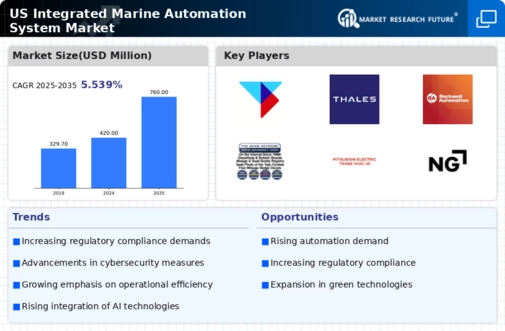The US Integrated Marine Automation System Market is characterized by a dynamic competitive landscape, shaped by technological advancements and evolving regulatory frameworks. Companies operating within this sector focus on integrating various subsystems to enhance operational efficiency, safety, and reliability in marine environments. The market influences companies to innovatively develop sophisticated automation solutions that cater to a wide array of applications, including navigation, control, monitoring, and communications. As the demand for advanced automation systems continues to grow, key players are strategically positioning themselves to leverage opportunities while addressing the unique challenges within the maritime industry.
The competitive insights reveal a blend of established firms and emerging entities, each striving to differentiate their products and services to meet the demands of a modern fleet.Emerson Electric has carved a strong presence in the US Integrated Marine Automation System Market through its commitment to innovation and quality. With a diverse portfolio of automation technologies, the company delivers robust solutions that enhance vessel performance and safety. Emerson Electric's longstanding reputation in providing reliable and efficient systems has allowed it to build strong relationships with clients in the marine sector.
One of the key strengths of Emerson Electric is its focus on customer-centric solutions, integrating cutting-edge technologies and offering comprehensive support and training. This has led to a consistent market presence and a growing share in marine automation. The company’s ability to adapt to changing market conditions and regulations, combined with its strong R&D capabilities, further solidifies its competitive stance in the market.Raytheon Technologies is another pivotal player in the US Integrated Marine Automation System Market, offering a wide range of products and services designed to enhance maritime operations.
With a focus on advanced technologies, Raytheon Technologies provides integrated solutions that optimize navigation, communications, and control systems. The company is known for its innovation in defense and aerospace sectors, translating that expertise into its marine offerings. Raytheon Technologies enjoys a robust market presence, bolstered by strategic mergers and acquisitions that enhance its capabilities and resources. This expanding portfolio, which includes advanced radar systems and cybersecurity solutions, positions Raytheon Technologies as a leader within the integrated marine automation space.
Their focus on technological advancements and the seamless integration of systems and services is a significant strength that resonates within the US marine industry, allowing them to tackle complex challenges and maintain operational excellence for their clients.





















